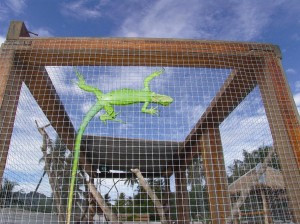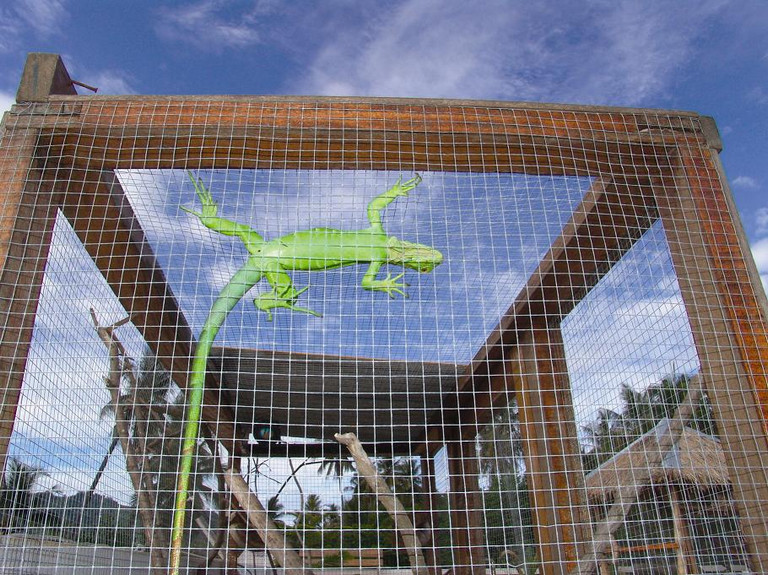Into the Great Wide Open
Erik J. Martin //April 4, 2014//
They say no man is an island. Likewise, no reptile should be permanently isolated on an island in the form of an indoor terrarium, which is why outdoor enclosures were invented.
Available in greater varieties than ever before, outdoor habitats provide a way for pet owners to bring their herps outdoors in warmer weather climates to partake in all the best that Mother Nature has to offer, including fresh air and the sun’s ultraviolet rays. 
While we can provide worthy artificial means of UVA and UVB, it can’t top sun basking, which helps in synthesizing vitamin D, needed for necessary calcium absorption from the intestines and to prevent nutritional metabolic bone disease and other problems, and to encourage natural behaviors.
But it’s not enough to simply move a cage near a window or to take a glass enclosure outdoors for a spell. Glass can filter out UVB from sunlight, which is why reptiles can best benefit from unfiltered exposure to direct sunlight whenever possible. Fortunately, a range of cages, tubs, playpens and other habitats designed for outdoor use are available that provide the ideal solution.
Outdoor Fun
Zilla’s Fresh Air Screen Habitat is a more vertically oriented cage designed for tree-dwelling herps like crested geckos and chameleons. Offered in small (18 inches long by 12 inches wide by 20 inches height) and large (18 inches long by 30 inches wide by 30 inches height) sizes, this cage consists of escape-resistant black mesh, water-resistant PVC base and an aluminum frame, and features a cord-access port to accommodate tubing and power cords.
One of the simplest and most space-saving products on the market is Exo Terra’s Explorarium, a compact, nylon mesh enclosure offered in three sizes (12 inches by 18 inches, 18 inches by 24 inches, and 24 inches by 36 inches) that instantly springs to life from its flat carrying case when opened. This terrarium provides excellent ventilation, is extremely easy to transport, and can be hung from a desired location or placed on a tabletop. An included Flextray can hold food and drink containers and substrate.
Turtle owners can turn to Zoo Med’s 13-gallon Turtle Tub, offered as a standalone product or with a bundled kit that includes a heat lamp and stand, mini deep dome lamp fixture, coconut fiber substrate, water conditioner and more. This lightweight tub, which can be easily carried outdoors, boasts a built-in water and land area that encourages natural basking and egg-laying behavior.
Aside from the obvious perks of natural light and fresh air, bringing a reptile outdoors offers excellent exercise opportunities, Brian Wittcop, manager for Steve’s Wonderful World of Pets, in Buffalo, N.Y., said.
“In a distraction-free environment, it provides a great way to interact and bond with pets and foster healthy socialization,” Wittcop said. “A lot of reptiles that spend most of their lives indoors don’t get proper exercise.”
In a state like Florida that’s famous for its year-round sunshine and lizard-friendly temperatures, outdoor habitats are popular items at pet stores, Austin Harris, manager for Underground Reptiles in Deerfield Beach, Fla., said.
“A lot of customers buy tortoise pens and screen cages, and many also build their own custom outdoor cages,” Harris said. “Our store actually provides design templates, supply lists and video tutorials on our website that allow owners to do it themselves for around $250 and up for a large cage.”
Show It to Them
Ashley Rademacher, animal care and education coordinator for Zoo Med Labs, said setting up an outdoor habitat in a store is one of the best ways to display these products.
“Retailers can set up an inspirational habitat and allow customers to imagine this enclosure in their home or yard,” Rademacher said. “I also recommend having an enclosure set up in the store with an animal in it. I even have some stores put their enclosures outside when weather is appropriate. Not only does this bring more customers into the store, but people are very intrigued and start asking questions, which gives you an opportunity to properly educate them on the safekeeping of pet animals.”
When informing customers about the advantages of outdoor enclosures, recommend several tips.
Test the enclosure for any weak points before transporting it outside, including tears in the mesh. Supervise and monitor the animal while it’s kept outdoors to prevent escape from the enclosure, attack from another animal or adverse exposure to the elements.
Try to position the enclosure in a sunny area, but provide shaded spots inside that allow the animal to take refuge from the sun if it desires.
Be careful while handling a reptile outdoors to ensure that it doesn’t escape; sudden exposure to a new, unknown environment can startle animals and make them nervous, agitated and more prone to flee.
“Some animals will display behaviors outdoors that they do not while inside,” Rademacher said. “Providing environmental changes, such as a trip outdoors, can be stimulating and very healthy for pet reptiles. Educating keepers about their reptiles’ need for enrichment and how they can provide for this need benefits not only the retailer, but the keepers and their pets as well.”



















